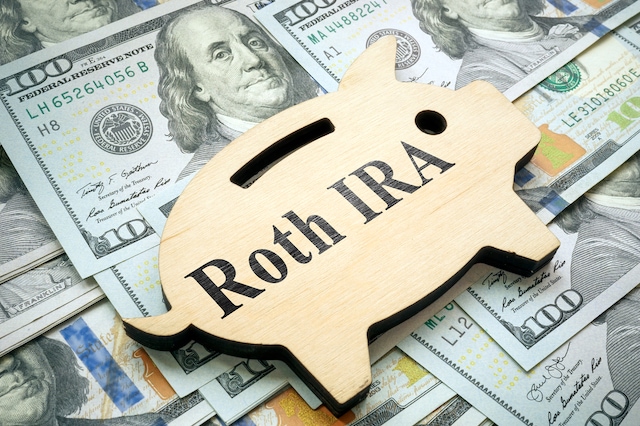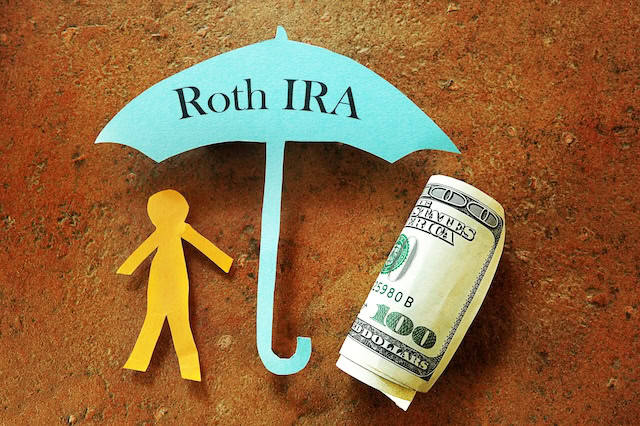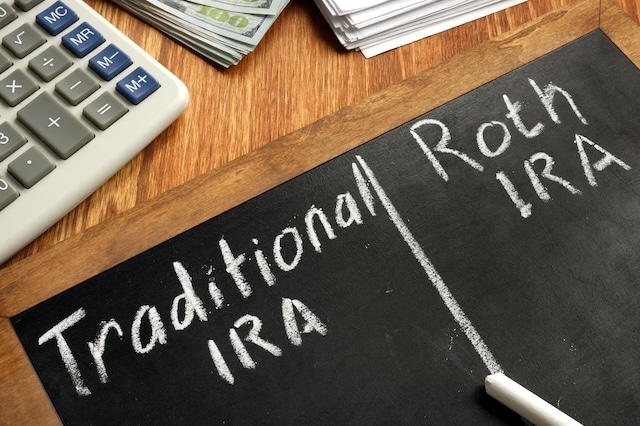Saving for retirement is one of the primary goals of financial planning … and individual retirement accounts (IRAs) are one of the most important vehicles for achieving your retirement saving goals.
However, you can only put so much in IRAs each year. The U.S. tax laws include IRA contribution limits that restrict how much you can squirrel away in IRAs during the year. The amount you can put in a Roth IRA each year can also be reduced (potentially to zero) if your income is above a certain amount.
The good news is that the IRA contribution limits and Roth IRA income limits are adjusted each year to account for inflation.
The better news is that the IRS has released the new limits for 2026, and despite moderating inflation, you’ll be able to put more money away in your IRA account in 2026 than you could in 2025.
Check out the new IRA contribution limits and Roth IRA income limits below, and see how much you can save for retirement in 2025 and 2026 with your IRAs.
Related: 401(k) Contribution Limits for 2026
Featured Financial Products
Traditional IRAs vs. Roth IRAs
Before getting into the IRA contribution limits and Roth IRA income limits for 2025 and 2026, it’s probably best to explain the differences between traditional IRAs and Roth IRAs. The key difference is how—or should I say, when—they are taxed.
With a traditional IRA, your contributions are made with “pre-tax” dollars. That generally means contributions are tax-deductible in the year you make them (although your tax-deductible contributions might be limited if you or your spouse is covered by a workplace retirement plan or your income is too high). Money in the account then grows on a tax-deferred basis, and is subject to federal income tax when you make withdrawals in retirement.
On the other hand, contributions to a Roth IRA are made with “after-tax” dollars. In other words, they’re not tax-deductible. However, funds in the account grow tax free, so you won’t pay taxes on withdrawals in retirement.
In addition, you might also qualify for a tax credit of up to $1,000 ($2,000 for married couples filing a joint tax return) for putting money into either a traditional or Roth IRA. However, this credit—commonly called the Saver’s Credit—is only available to low- and moderate-income individuals. So, to claim the credit, your federal adjusted gross income (AGI) must be at or below a certain amount, which is based on your filing status.
Related: IRA vs. 401(k): How These Retirement Accounts Differ
Early Withdrawal Penalties
A 10% early withdrawal penalty might apply if you take money out of an IRA too soon.
With a traditional IRA, you might be hit with the penalty if you withdraw money from the account before you’re 59½ years old. The penalty is in addition to any income tax imposed on the amount withdrawn.
The penalty is less likely to apply when you take money out of a Roth IRA. Any contributions you make to a Roth can be withdrawn tax free and penalty free at any time. However, if you withdraw investment gains before age 59½, you might have to pay taxes and the 10% early withdrawal penalty.
There are exceptions to the 10% early withdrawal penalty, though. Penalty-free withdrawals from either a traditional or Roth IRA are possible if the money is used to pay certain education expenses. A one-time early withdrawal of up to $10,000 is also permitted if the money is used for a first-time home purchase. Other exceptions might also apply.
Finally, you’re also required to take out a certain amount of money from a traditional IRA each year when you turn 73 years old. These mandatory withdrawals are called required minimum distributions. They aren’t necessary with Roth IRAs, though.
Related: 10 Best Investments for Roth IRA Accounts
IRA Contribution Limits for the 2025 Tax Year

For the 2025 tax year, the annual contribution limit for a traditional or Roth IRA is $7,000 for people under age 50. That’s unchanged from 2024.
If you’re 50 or older, you can contribute an additional $1,000 for the 2025 tax year (same amount as in 2024), called a “catch-up” contribution. That means you can kick in a total of $8,000 for 2025 (unchanged from 2024).
The annual limits are combined limits that apply to all your traditional and Roth IRAs. So, for example, if you’re under age 50 and put $5,000 in a traditional IRA in 2025, then you can’t put more than $2,000 in a Roth IRA (or any other IRA) for the 2025 tax year.
YATI Tip: You have until the tax filing deadline for the year to make contributions to an IRA. So, for example, you have until April 15, 2026, to put money in an IRA for the 2025 tax year. If you request an automatic filing extension for your 2025 tax return, you’ll have until Oct. 15, 2026, to contribute to an IRA for the 2025 tax year. Similar deadlines will apply for 2026 IRA contributions.
Related: 10 Best Rollover IRA Accounts [Where to Roll Over a 401(k)]
IRA Contribution Limits for the 2026 Tax Year

Things look sunnier for the 2026 tax year.
The annual contribution limit for traditional and Roth IRAs will increase to $7,500 for people under age 50, which is $500 better than it was in 2025.
Catch-up contributions got a little sweeter, too. If you’re 50 or older, you can contribute an additional $1,100 for the 2026 tax year, which is $100 better than it was over the past couple of years. That means if you’re 50 or older, you can contribute a total of $8,600 to your IRAs in 2026.
“The new 2026 retirement plan limits give people more room to save, which is especially helpful as retirement gets longer and more expensive,” says Lisa Featherngill, National Director of Strategic Wealth and Business Advisory at Comerica Wealth Management. “Higher limits for 401(k), 457, and similar plans—along with bigger catch-up contributions—make it easier for workers to put away more money each year.”
Related: 10 Best Rollover IRA Accounts [Where to Roll Over a 401(k)]
Roth IRA Income Limits for the 2025 Tax Year

The amount you can contribute to a Roth IRA might be less than the year’s IRA contribution limit (and possibly $0) if your income is above a certain amount. That’s because Roth IRAs also have income limits that you need to worry about if you’re a high-earner.
As with the basic IRA contribution limits, the Roth IRA income limits are adjusted for inflation each year. The IRS released the new income limits for 2025 when it announced the general IRA contribution limits.
For the 2025 tax year, the maximum amount you can contribute to a Roth IRA is gradually reduced to zero if your 2025 modified AGI is:
- $150,000 to $165,000 for single and head-of-household filers ($146,000 to $161,000 for 2024)
- $236,000 to $246,000 for joint filers ($230,000 to $240,000 for 2024)
That also means you can’t contribute to a Roth IRA at all for 2025 if your modified AGI for the year is:
- $165,001 or more if you use the single or head of household filing status on your tax return ($161,001 for 2024)
- $246,001 or more if you’re married and file a joint return ($240,001 for 2024)
If you’re married but file a separate tax return, your annual maximum contribution is gradually reduced to zero if your modified AGI is between $0 and $10,000.
Roth IRA Income Limits for the 2026 Tax Year

Along with the higher IRA contribution limits for 2026, the IRS also announced new income limits for those who would contribute to a Roth IRA in 2026.
For the 2026 tax year, the maximum amount you can contribute to a Roth IRA is gradually reduced to zero if your 2026 modified AGI is:
- $153,000 to $168,000 for single and head-of-household filers ($150,000 to $165,000 for 2025)
- $242,000 to $252,000 for joint filers ($236,000 to $246,000 for 2025)
That also means you can’t contribute to a Roth IRA at all for 2026 if your modified AGI for the year is:
- $168,001 or more if you use the single or head of household filing status on your tax return ($165,001 for 2025)
- $252,001 or more if you’re married and file a joint return ($246,001 for 2025)
If you’re married but file a separate tax return, your annual maximum contribution is gradually reduced to zero if your modified AGI is between $0 and $10,000.
Related: Roth IRA vs. 529 Plan: Which Is Better For College Savings?
Where to Open an IRA

If you currently don’t have a traditional IRA or Roth IRA, perhaps now is the time to open one. Even if you have a 401(k) account through your employer, you can still contribute to an IRA—and save even more for retirement.
In fact, when starting a retirement plan and building retirement savings, it’s common to use a variety of retirement accounts at once (this can include the use of health savings accounts, too). You can also use a mix of traditional and Roth accounts for greater tax diversification.
So, if you’re looking to open an IRA, we suggest going with a highly reputable financial institution. You can learn more about two such IRA providers that we recommend below.
SoFi Invest IRAs

- Account minimum: None
- Minimum initial deposit: None
- Fees: No annual or opening fees; $20 closing fee
SoFi offers many perks to its customers, including no annual or opening fees on many different account types. Its SoFi Invest traditional IRA or Roth IRA could be a good choice if you’re an existing SoFi customer.
SoFi offers two options catering to different investment styles. Its active investing option lets you choose and manage your own investments. And with its automated investing option, SoFi will select and manage investments on your behalf.
You won’t pay management fees with either account option, and SoFi doesn’t charge commissions for stock or ETF trading. Several other investment choices are also available, including options and margin trading. However, underlying fund fees may apply depending on the investments you choose, and you will have to pay a modest $20 fee to close your account.
As a platform: SoFi’s interface is still very much geared toward younger, less experienced investors—everything is focused on simplicity and ease of use, rather than an expanse of sophisticated tools. SoFi also offers budget-friendly features such as fractional shares, which allow you to invest for as little as $5.
- SoFi Invest's IRAs allow you to trade or invest in stocks, ETFs, and options with no commissions (or options contract fees) and no account minimums.
- Invest for as little as $5 with fractional shares.
- Robo-advisory services, including goal planning and auto-rebalancing, available for annual 0.25% AUM fee.
- Subscribe to SoFi Plus ($10/mo.) to unlock more than $1,000 per year in extra value, including a 1% match on recurring investment deposits, preferred IPO access, higher cash-back rewards on certain SoFi credit cards, a six-month APY boost, and more.
- No opening fees
- Good selection of available investments
- No options contract fees
- DIY and robo-investing options
- Fractional shares
- Modest closing fee ($20)
- No mutual funds
- Limited trading tools
- No tax-loss harvesting
- No socially responsible robo-advisor functionality
Betterment IRAs
- Account minimum: None
- Minimum initial deposit: $10
- Fees: $4/mo. or 0.25% annually
Investing in ETFs can be a smart way to diversify your portfolio, and Betterment’s traditional IRAs and Roth IRAs are ideal vehicles for ETF investments—which are the only option available in the account.
Betterment offers several low-cost ETFs from major fund providers that align with different themes and investments. If you’d like to invest in socially responsible companies, for example, you might choose to buy shares of its Broad Impact ETF, which focuses on companies highly ranked for environmental, social, and governance (ESG) factors.
Keep in mind that Betterment is primarily a robo-advisor, so if you prefer to be hands-on with your investments, it might not be the best choice. That said, you can connect with human advisors to get guidance on your account. The option to talk with a financial professional makes Betterment fairly unique among robo-advisors.
Betterment charges an annual fee of 0.25% or a monthly fee of $4. You can upgrade to Betterment Premium for an additional 0.15% add-on fee to receive on-demand support from a Certified Financial Planner™. Upgrading requires a $100,000 minimum balance required in cash, stocks, bonds, or crypto holdings.
Click “Get Started” below to learn more.
- Betterment IRAs give you the tools, inspiration, and support you need to become a better investor.
- Start with as little as $10 and use the top-rated mobile app to set up automatic investing into diversified ETF portfolios.
- By upgrading to Premium, you can unlock unlimited financial guidance from a Certified Financial Planner™.
- Hands-off investment management
- Diversified portfolio that automatically rebalances
- Low-cost investment selection
- High account fees
- Limited investment selections
Related:










![Should You Max Out Your 401(k) Each Year? [Yes...and No] 23 should you max out your 401k each year or invest elsewhere](https://youngandtheinvested.com/wp-content/uploads/should-you-max-out-your-401k-each-year-or-invest-elsewhere-600x403.jpg)

